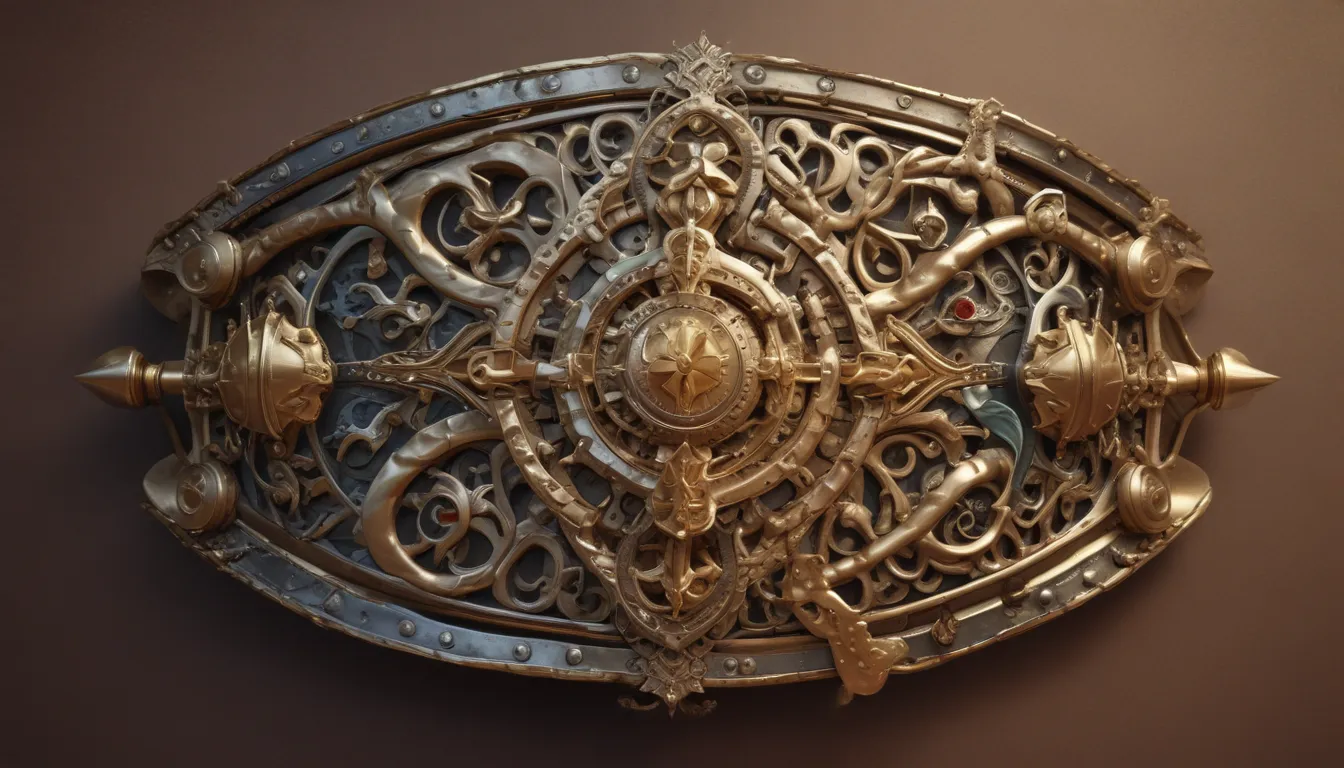The images in our articles may not match the content exactly. They are used to grab your attention, not to show the exact details in the text. The images complement the text but do not replace it.
Do you ever find yourself curious about the enigmatic past of chastity belts? These devices, often cloaked in myths and medieval legends, have a captivating history that goes beyond mere control and virtue. They reflect the evolution of societal norms and personal freedoms throughout different eras. From their alleged use in the Middle Ages to safeguard a woman’s virtue while her knight was away, to the ongoing debate among historians about their actual existence and purpose, the history of chastity belts is rife with surprises. Let’s embark on a journey back in time and unearth some of the most compelling facts about these iconic symbols of chastity. Get ready to debunk myths and uncover truths about one of history’s most talked-about inventions.
Delving into Chastity Belts: What Exactly Are They?
Chastity belts, often linked to the Middle Ages, were contraptions designed to prevent sexual intercourse or masturbation. Typically crafted from metal, these devices were secured around the waist for the intended purpose. Let’s unravel some intriguing details about their historical background.
-
Origins: Contrary to popular belief, there is scant evidence supporting the notion that chastity belts were utilized during the Middle Ages. Nowadays, historians tend to believe that they were predominantly a product of the Renaissance, crafted to evoke a more “barbaric” medieval image.
-
Renaissance Tales: The earliest known mentions of chastity belts emerge in 16th-century texts, indicating that they likely originated in the Renaissance era rather than the medieval period.
-
Patents: The oldest surviving patent for a chastity belt dates back to 1889, emphasizing the absence of this device in earlier historical records.
The Purpose Behind Chastity Belts: Untangling Fact from Fiction
-
Infidelity and Chastity: Some narratives suggest that Crusaders utilized chastity belts to ensure their wives’ fidelity while they were away on missions. However, these accounts are steeped more in myth than reality.
-
Slavery and Control: In certain instances, chastity belts were wielded as instruments of control and oppression, particularly in scenarios involving slavery to prevent sexual assault or as a punitive measure.
-
Medical Use: From the 19th to the early 20th centuries, chastity belts were occasionally prescribed as a means to prevent masturbation, a practice erroneously believed to induce mental and physical ailments.
Unveiling the Design and Materials of Chastity Belts
-
Materials: Initial designs purportedly comprised metal, although leather and cloth versions also existed. Metal was not always favored due to its discomfort and potential for causing injuries.
-
Comfort: Despite their intended purpose, certain chastity belts were purportedly devised with comfort in mind, featuring padded linings and apertures for bodily functions.
-
Locks: The locks on chastity belts were often intricate, with some necessitating unique keys to unlock. This complexity was aimed at ensuring that only the designated keyholder could remove the device.
Chastity Belts in Modern Times: Evolution and Contemporary Usage
-
Fetish and BDSM: In contemporary times, chastity belts are primarily associated with the BDSM community, where they are employed consensually in sexual play and power dynamics.
-
Women’s Safety: In certain regions, modern iterations of chastity belts have been marketed as a safeguard against sexual assault. Nevertheless, this application is contentious and criticized for placing the burden of preventing assault on the victim.
-
Art and Media: Chastity belts have made appearances in various art forms, literature, and films, often symbolizing purity or the regulation of one’s sexuality. They serve as potent metaphors in diverse narratives.
Debunking Misconceptions and Myths Surrounding Chastity Belts
-
Widespread Use: One prevalent misconception regarding chastity belts is their purported widespread use in the Middle Ages. In reality, their utilization was likely rare and more symbolic than practical.
-
Hygiene: Another fallacy is the assumption that historical individuals were unconcerned about hygiene. Wearing a metal chastity device for prolonged periods would have been unsanitary and hazardous, potentially leading to infections and other health issues.
-
Female Oppression: While chastity belts are frequently cited as tools for oppressing women, the historical reality of their implementation for this purpose remains debatable. Many stories surrounding their alleged use are likely exaggerated or entirely fictional.
The Enduring Fascination with Chastity Belts: Exploring Various Perspectives
-
Cultural Symbol: Chastity belts have evolved into a cultural symbol representing chastity, purity, and self-regulation concerning one’s body and sexuality.
-
Museum Pieces: Several museums exhibit items that they claim to be medieval chastity belts, although many of these artifacts are now deemed to be forgeries or misinterpretations of their original function.
-
Collectors’ Items: Despite their contentious history, chastity belts hold appeal for collectors of medieval artifacts and enthusiasts interested in the history of sexuality.
-
Educational Tools: These devices function as educational resources in discussions concerning the history of sexuality, gender dynamics, and the regulation of women’s bodies throughout varying historical epochs.
-
Modern Redesigns: Contemporary designers have developed modern renditions of chastity belts for both aesthetic and practical purposes, blending historical design elements with contemporary technology and materials.
-
Psychological Aspect: The psychological underpinnings of wearing a chastity belt, be it in historical times or modern BDSM practices, revolve around issues of control and the yielding or seizing of power.
-
Legal and Ethical Concerns: The utilization of chastity belts raises apprehensions pertaining to legality and ethics, particularly in instances involving consent issues or the potential for abuse.
-
Pop Culture References: From cinematic productions to literary works, chastity belts are frequently utilized for comedic effect or as plot devices, showcasing their enduring presence in popular culture.
-
Misunderstood Artifact: Despite their notoriety, chastity belts rank among the most misconstrued artifacts in history, with prevalent beliefs about them often stemming from myths and inaccuracies.
-
Symbol of Oppression or Protection?: The interpretation of chastity belts as either instruments of oppression or protection varies based on cultural, historical, and personal viewpoints.
-
Role in Gender Studies: Chastity belts play a pivotal role in gender studies, offering insights into historical perspectives on sexuality, purity, and control.
-
Continued Interest: The enduring intrigue surrounding chastity belts underscores a broader fascination with historical traditions relating to sexuality and control, as well as the human inclination to comprehend the past, regardless of how unconventional or misunderstood it may be.
A Final Glimpse into the World of Chastity Belts
Chastity belts, often cloaked in myths and misinterpretations, boast a captivating history spanning centuries. Contrary to common belief, their prevalence in enforcing fidelity during medieval times was likely overstated, with most narratives from that era now regarded as more fiction than fact. Transitioning into the Renaissance and beyond, these devices found a niche in literature and comedy rather than practical application. Presently, they are examined through a lens that amalgamates historical curiosity with a critical assessment of past attitudes towards gender and morality. Unraveling the authentic narrative behind chastity belts unveils valuable insights into human culture, societal transformations, and the progression of personal liberties over time. So, next time you encounter a tale concerning these intriguing artifacts, remember there’s a more intricate story beyond medieval lore.
Frequently Asked Questions
Q: What exactly is a chastity belt?
A: Think of a chastity belt as a lock-and-key system aimed at safeguarding one’s private parts, historically devised to inhibit sexual intercourse or masturbation. Originating from medieval times, these devices were purportedly worn by women to uphold fidelity while their spouses were absent.
Q: How did chastity belts come into existence?
A: Legend holds that chastity belts were first utilized during the Crusades, as knights supposedly locked up their partners before embarking on battle. However, most historians contend that these narratives are more myth than reality, proposing that chastity belts were likely invented later for differing purposes.
Q: Were chastity belts solely worn by women?
A: While prevalent accounts focus on women wearing chastity belts, there are records and artifacts indicating that men also utilized similar devices to ensure fidelity or practice celibacy.
Q: Do modern chastity belts exist?
A: Yes, but their function has evolved. Contemporary chastity belts are predominantly found in the BDSM community, serving as a component of kink linked to power exchange rather than the historical intentions of enforcing fidelity or celibacy.
Q: How did individuals manage hygiene while wearing these belts?
A: Hygiene posed a significant challenge for wearers of historical chastity devices. While designs varied, many did not allow for easy cleaning, resulting in health complications. Modern versions are crafted with hygiene considerations, facilitating better care and maintenance.
Q: Did chastity belts effectively prevent infidelity?
A: The effectiveness of a chastity belt in preventing physical sexual intercourse is debatable. However, emotional infidelity and desires could not be thwarted by the device. Additionally, there were ways to tamper with or remove the belt, casting doubt on its efficacy.
Q: Can one view a chastity belt in a museum?
A: Certainly! Numerous museums worldwide exhibit chastity belts, purporting them to be authentic historical relics. Nonetheless, some of these artifacts have been proven to be counterfeits or misinterpretations of their original purpose.
In Conclusion
Chastity belts hold a unique place in history, blending truth with fiction, symbolism with functionality. Their journey from mythical medieval artifacts to modern-day BDSM accessories underscores the evolution of societal attitudes towards control, sexuality, and gender dynamics. By untangling the web of misconceptions and peeling back the layers of their enigmatic past, we gain a richer understanding of how chastity belts reflect broader cultural shifts and individual freedoms across different eras. As these devices continue to intrigue and provoke curiosity, they serve as reminders of our complex relationship with power, desire, and personal agency throughout the annals of time.






